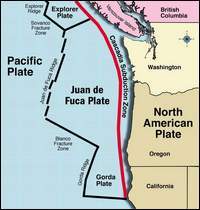
|
| ©Keith Thorpe / PDN |
Generally, the Cascadia quakes preceded the California quakes by 25 to 45 years.
"It's either an amazing coincidence, or one fault triggered the other," said Chris Goldfinger, associate professor of marine geology and geophysics at Oregon State University.
"Even if the details are fuzzy - something is going on."
He and his colleagues published their research in the April issue of the Bulletin of Seismological Society of America this week.
The team also found evidence that the southern part of the Cascadia fault may unleash earthquakes much more frequently than previously believed - about every 200 to 240 years rather than every 500 to 600 years.
The last major quake along the entire Cascadia fault - which stretches from Vancouver Island to Northern California - occurred in 1700.
It dropped parts of the Olympic Peninsula coast by five feet and triggered a tsunami that pounded the Pacific Northwest and washed away houses in Japan.
"It's been 308 years since the last one," Goldfinger said. "We've actually exceeded the average repeat time for the southern half."
Geologists used to scoff at the possibility that earthquakes could beget other earthquakes on distant faults, but no more.
In 1992, an earthquake in the Mojave Desert was followed almost immediately by a dozen quakes as far away as Wyoming.
A 2002 quake in Alaska caused geysers to spew in Yellowstone National Park.
"The Earth is like a puzzle, and any time one piece moves, it interacts with other pieces," Goldfinger said.
Bigger quakes
It makes sense that the bigger Cascadia fault, where the ocean floor is being subducted under the continental plate, would be the instigator, said University of Washington geologist Brian Atwater.
"The earthquakes on Cascadia dwarf those of the San Andreas fault," said Atwater, whose field work uncovered evidence of Cascadia's destructive history along the coast.
But he cautioned that Goldfinger's conclusions about the frequency of earthquakes are based on a relatively new method that is still being evaluated.
The research relies on analysis of sediment cores up to 30 feet long, drilled from the floor of undersea canyons.
When the ground shakes during major earthquakes, landslides slough into those canyons, leaving behind layers of coarse grains called turbidites.
Goldfinger and his colleagues compared cores, looking for evidence of large quakes that would have caused shaking - and landslides - over a wide area.
"The turbidites are very much like fingerprints," he said. "We match these fingerprints from place to place and look at them in great detail."
The team found sediment tracks it says point to 20 major Cascadia quakes of magnitude 9 over the past 10,000 years.
In the southern portion of the fault - off the coast of Southern Oregon and Northern California - it found a total of 36 events, including smaller quakes, leading to the conclusion that the fault slips more frequently there, an average of once every 220 years.
For us, 500 to 600 years
On the northern part of the fault - off the Olympic Peninsula coast - the sediment data support a 500- to 600-year recurrence interval.
The team began to notice the synchronicity between the faults when it compared cores and earthquake dates from the Pacific Northwest and California.
Thirteen of 15 San Andreas quakes were closely linked with Cascadia quakes.
Because of uncertainty in radiocarbon dating, the team used statistical analysis and evidence from stress studies on the faults to conclude the Cascadia quakes probably came first.
The two faults meet off California's Cape Mendocino.
The prevailing theory is that when Cascadia slips, it puts more pressure on San Andreas, which is then more likely to slip itself, Goldfinger explained.
But the picture isn't perfect.
Two seismic events on the San Andreas were apparently not associated with Cascadia, including the devastating 1906 San Francisco earthquake which followed the previous Cascadia earthquake by about 200 years.



Reader Comments
to our Newsletter